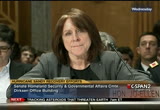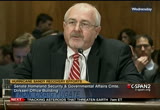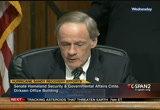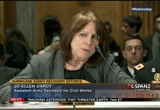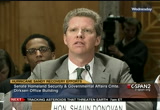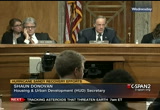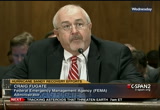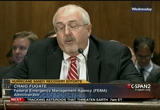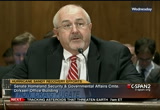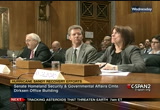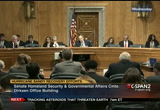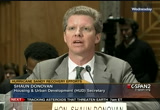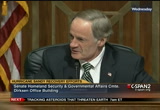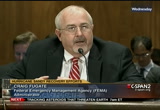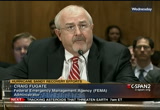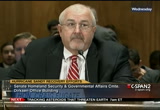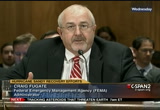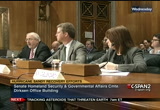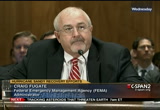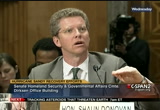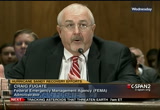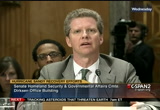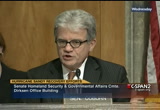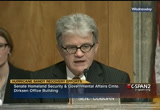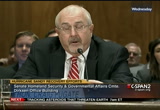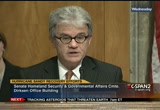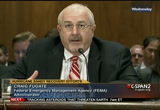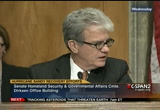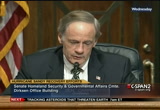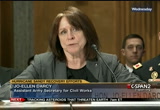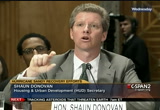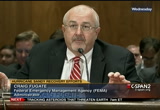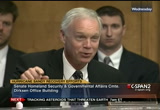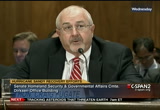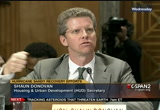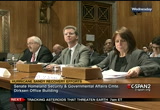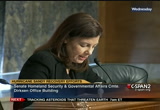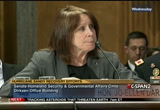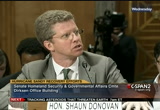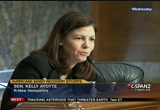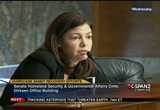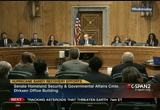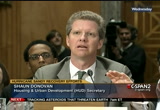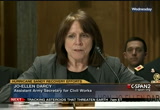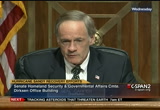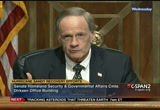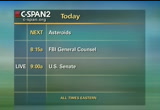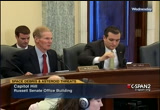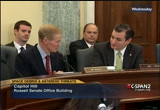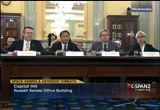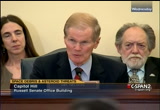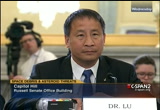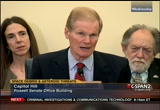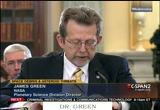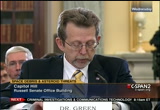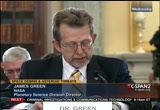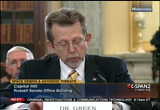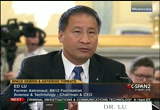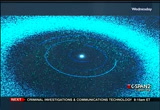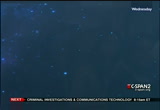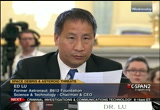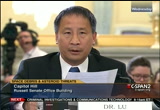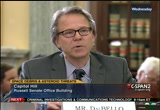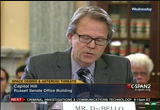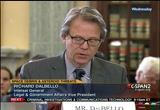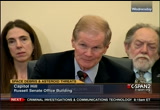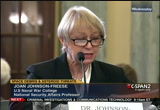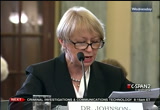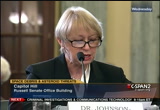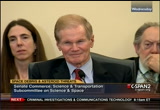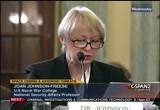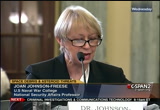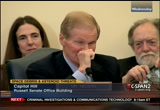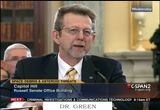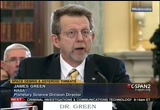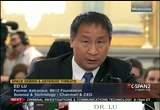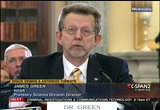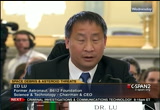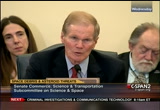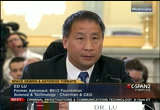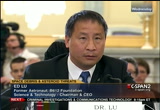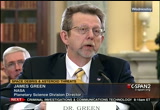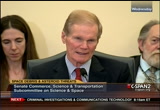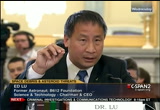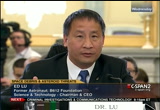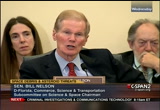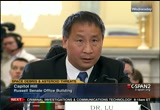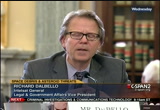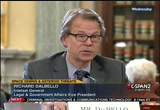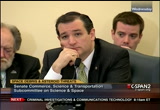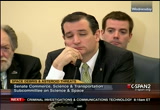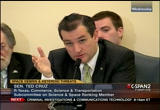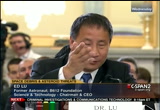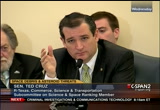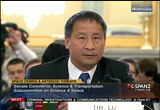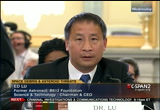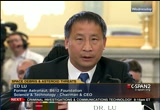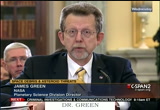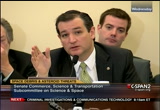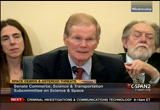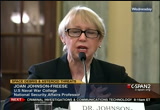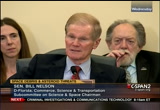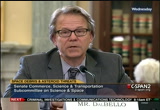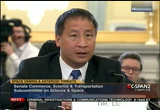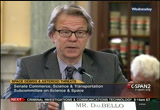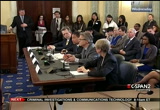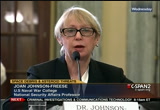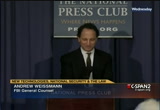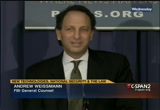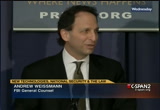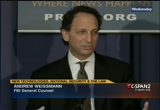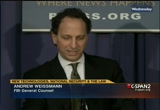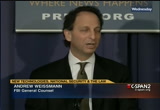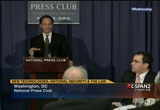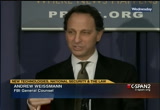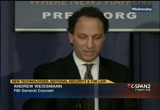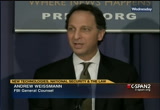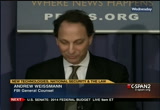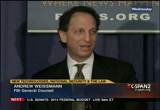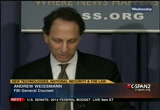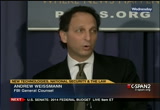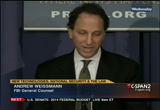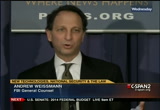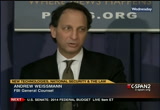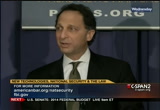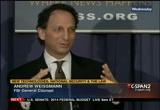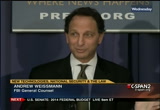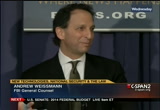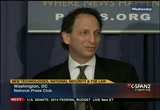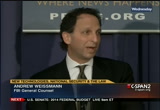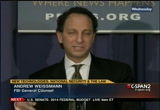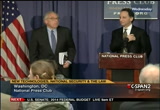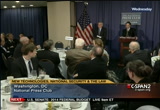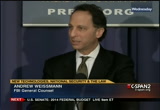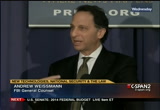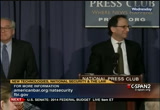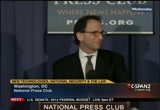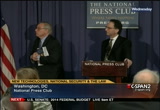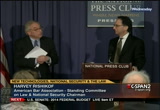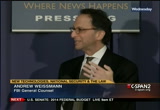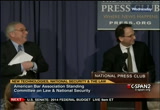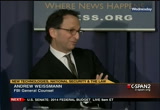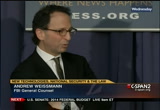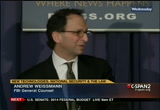tv Today in Washington CSPAN March 21, 2013 6:00am-9:00am EDT
6:59 am
7:00 am
>> our conversation with the stories on elizabeth monroe is now available on our website. c-span.org/first lady's. >> the explosion of immediate over russia last month injured 1500 people. discussion about the risk posed by asteroids and other near earth objects. scientist testified about how these objects are tracked and how those risks can be minimized. this senate commerce, science and transportation subcommittee hearing is an hour 15 minutes. >> [inaudible] >> good morning. we are delighted to have this meeting in the new congress of our science and space
7:01 am
subcommittee. nasa and the space programs have been in the news a lot in the past year. some really impressive feats, and we're going to be talking about some of those from rover on mars to the birthing of the spacex capsule at the international space station. i am delighted to have my colleague, senator chris in texas, as our ranking member. -- senator chris. it seems like texas and florida have some interest in the space program. and i'm looking forward to his leadership and i would ask for his opening statement. >> well, thank you, mr. chairman. let me echo those sentiments and say how much i'm looking forward to working with you on this
7:02 am
subcommittee. spaceflight and our capacity to maintain world leading advantage in spaceflight is a critical priority for the nation. and certainly a critical priority both for the state of texas and the state of florida, and so i am eager for our collective journey to ensure that nasa and all the related programs have sufficient resources, sufficient priority to do what needs to be done. and i appreciate all of the witnesses coming here today to address these important topics, and also to begin the process of what i hope this subcommittee will do over the coming years, which is continuing to make the case to the american people about the importance of these programs, about the benefits
7:03 am
that they produce for the private sector, for men and women across this country. and at the same time looking for ways to improve those benefits, to expand the cooperation that we presently have between nasa and the private sector, and to look for ways to even further increase the positive benefits that are realized in everyone's day-to-day life. so i'm eager in looking forward to working together. >> thank you, senator. in the interest of time, we're going to compress things today, because there have been three roll call votes called at 11:15. so i'd like to see if we can get the bulk of the hearing in the time before the votes take place so that we can be mindful of
7:04 am
your time. because those votes will stretch out over some period of time. and we're going to get into some interesting stuff here today on space debris and also asteroids, possibly hitting the earth. so we want to have time to cover this. let me suggest that each of you keep your comments to five minutes so that we will have a chance to get in depth to some of the question. we have dr. james green, director of the planetary science division in nasa's science mission directorate. we have former astronaut, doctor ed lu, two shuttle flights and a six-day stay on the international space station. he's now the chairman and ceo of the b612 foundation and is going to talk to us about his
7:05 am
foundation said no, which is to track the near earth objects. and then mr. richard dalbello, vice president of government affairs for intelsat, who's going to speak about the economic role of satellites and the commercial and security implications from the space threats. and then dr. joan johnson-free johnson-freese, professor of national security affairs at u.s. naval war college. she's going to talk about the role of space in our daily lives and how the space threats can threaten our national security. we will put our formal statements for senator cruz and mine in the record. your written testimony will be inserted into record. and if you just give us a quick
7:06 am
summary so we can get into the questions. please. >> trying to i will confess given this topic today i was disappointed that bruce willis was not available to b the of ts witness to testify on the panel. >> we might get a trailer from armageddon, and show that. >> mr. chairman and members of the subcommittee, i am pleased to have the opportunity to update the committee on nasa's programs and our approach to addressing the risks, impacts, and solutions for space threats. one space threat is near earth objects, or neo's. neos are asteroids and comets that enter the near earth space. their primitive leftover building blocks of the solar system, making them also compelling objects for scientific study. today, we do not have a complete inventory of all the possible impacts. nasa was passed by congress in
7:07 am
the 1998 to catalog 90% of all the large neo's within 10 years. a large neos are those that are one kilometer or more in size. a large neo would cause a global catastrophe if one struck the earth. nasa now is catalog after it has paid 95% of all they neo's over one kilometer in size. that said, none of these known large neo's pose any threat of impact to the earth within the 100 years. it is a situation we are constantly monitoring. in 2005, congress directed nasa to expand the survey to detect, track, and catalog neo's equal to or greater than 140 meters in diameter. congress set a goal for this program to be achieved, 90%
7:08 am
completed by 2020. for this expanded survey, nasa's neo program currently has three survey teams that operate five ground-based telescopes and are provided the nonprofit foundation, and b61 two, with support through space act agreement with a telescope that we'll hear about today. nasa continues to make daily progress on this goal. extreme space weather is another threat being studied by nasa. space weather infrastructure conditions on the sun and the solar wind and in the near earth environment. our ability to understand the system is of growing importance to our nation's economy and national security. the electric power industry is susceptible to geomagnetic light induced currents which can overload unprotected power grids and result in widespread power outages.
7:09 am
in the spacecraft industry, intense geomagnetic storms have the capacity to disrupt normal operation such as satellite communication, and, of course, they pose risks to astronauts in space. in addition, space weather can cause irregular areas in the signals from our very important global positioning systems. the national oceanic and atmospheric administration, or noaa is the official source for space weather prediction for the nation. several of nasa's research satellites have become essential part of our nation's space weather prediction system providing very important data for determined to space weather conditions. one such mission is the advanced composition explorer which sits in the solar wind ahead of the earth providing early warning of incoming solar storms. finally, orbital debris is the last space threat i will address today. the joint space operations
7:10 am
center managed by the u.s. strategic command is tracking more than 23,000 objects in orbit around the earth. of which about 95% represent some form of debris. in addition, millions of smaller debris objects that can potentially damage the spacecraft are orbiting the earth. nasa continues to lead the world in studies to characterize the near earth space debris environment. to assess its potential hazards to the current and future space operations, and to identify and implement means to mitigate its growth. in conclusion, nasa is making great progress in understanding measures for mitigation of these space threats. again, thank you for the opportunity to testify today, and i look forward to responding to any questions you may have. >> and you're going to put up, along with noaa and the air force, discover in late 2014,
7:11 am
for giving us early warning on sunday explosion, are you not? >> yes, sir, that is correct. indeed, discover is a mission moving for. it's a space weather mission. the first space weather endeavor at what we call l-1, and it is indeed on track. >> dr. lu. >> thank you, mr. chairman. i wanted to talk about asteroi asteroids. we are building the civil space telescope. that telescope will find and track asteroids but as we were you remind a couple go to the earth is sometimes if i asked what. russia had an asteroid exploded, that astrid was only about 18 meters across. that would fit inside this room. having energy about 25 times the bomb used in hiroshima or about
7:12 am
427 tons of tnt. the people were lucky. that asteroid exploded more than 60 miles from the city and still injured 1000. the last major impact before that was in 1908. that asteroid was about 500 times the explosive energy of hiroshima. it was only about a factor, not quite fit in this room but not much larger. i'd lik like to start a video to show you what the solar system really looks like. this is an anatomically accurate, depiction of all the known asteroids in our space. this is every single loan astrid. ones on the outside part of the, that is the asteroid belt. those are the ones that will not hit the earth, between mars and jupiter. the ones on the inside, those are the ones that could hit earth and those are the ones that dr. green talked about. those are the ones we're concerned with. there's about 10,000 known near
7:13 am
earth asteroids. however, we know that this is only a tiny fraction of those larger than the one that sharply of the windows are about 1 million. we do this by counting craters and knowing what small fraction of this guy we've been able to survey that's far from the ground. so it turns out of these 10,000 i'm showing here, the light green line is the orbit of the earth. there's about a factor of 100 more. for everyone we know about is 100 more we don't know about. we some but don't know when the next one will hit the earth because we don't know where they are. the real situation looks more like this. this is what it looks like with 1 million near earth asteroids. you see the earth is flying arounaround the solar system ina cosmic shooting gallery in some sense. that's why these things hit the earth. let me tell you about the odds of an asteroid hitting the earth. you may be surprised by these
7:14 am
odds. the odds of 100-megaton impact this entry, 100 megatons scale is about five times all the bombs used in world war ii. including the atomic weapons. a chance of that in your lifetime for this entry is about 1%. on a random spot the odds like we had in same goes to, about 30% and 40-meter asteroid, 30% chance. so if i told you that it was a 30% chance of a random five-megaton nuclear explosions on the surface of the earth this entry, what we do to prevent that. and how is the situation any different. yes most of the earth is unpopular. we could get lucky. but wouldn't be a shame if the area of the next impact was an area that wasn't unlikely that are less and less areas that are unpopulated. but there's good news. it turns out we have the technology to deflect asteroids if we have a decade or more of
7:15 am
notice. nasa has been working on this. the national academies has written a report on this. we understand how to deflect asteroids if we have advanced warning. he can't deflect anything, you can't explore anything, you cannot learn anything about something that you haven't yet found. that's the key. in the next video i'll show you what the b6 12 foundation is doing but we built a telescope, it's about the size of a fedex moving van. it is going to orbit the sun and it is going to track near earth asteroids. according to the national academies findings, the best way to find asteroids is in the infrared were asteroids are brighter, and from a vantage point where it can always look away from the sun. in orbit around the sun, something like -- optionally with this thing will orbit the sun and that's where you see the white discs. what it can see the light green
7:16 am
line is the orbit of the earth. so s&l goes around the sun faster than the earth does it will scan earth's orbit. you will find about 100 times more asteroids than all other telescopes combined. so far for way more effective than all other telescopes combined. in the first -- we have discovered as jim has said, about 10,000 near earth asteroids thus far with all of our telescopes over the last 30 years. said now will discover the, probably that number every two weeks. so what we an impressive instrument. we've is somewhat of the world's finest spacecraft teams to work on this, and we chose -- sentinel space on the design -- both of which were built by boss. we launched in july. a couple things make this project any. first the b612 sentinel project
7:17 am
is funded from tropical. we're a nonprofit and we will openly share the data with the world. second, we are managing this project in what i believe to be an innovative fashion. using commercial procurement practice. i proudly served at nasa for 12 years as an astronaut, and i also the approach of working at google. and i think that we using the best of both worlds in managing sentinel, which is the best in the world. with the innovative, rapid and cost effective methods that are learned at google. the secret to success as a learned of both of these organizations is hiring the very best people, and i think we've done that. i do want to talk about desperate to have a difficult and. we are a public-private partnership. we have a space act agreement to which nasa will be allowing us to use the deep space network a telescope, to transfer the data and also nasa experts are part of our team.
7:18 am
they're a very important part of our project. sentinel is important on a number of levels. not only what let us know if an asteroid will hit the earth but it will find asteroids that nearly come close to the earth. this happens all the time. disasters come close to the earth will be attractive targets for exploration, and robots in the coming is to associate an asteroid the thought of an impact trajectory, i'm reminded there's a 30% chance there is a five-megaton or impact that will hit as this century. so should we find one, i believe that humanity will come together to prevent this but we were user space technology to nudge the astro to prevent it from hitting the earth. and i think that will be a watershed moment in human history. so thank you very much. >> and we want to get into how you're going to nudge it away. and we'll get into that. mr. dalbello.
7:19 am
>> thank you, mr. chairman. santa cruz, it's a pleasure to be here today. talk about the issues of space risks and how that relates to the commercial sector. the commercial operators who are earning their living day-to-day in space. we've been in this business for about 50 years. we are currently flying about 70 satellites. so we're pretty summit with the space environment and the risks it entails but as a global fleet operator serving both commercial and government customers, reliability and continuity in service our highest prayers. whether or afghanistan or the final game of the ncaa tournament, or financial statements that have to be transferred around the world, we know that our customers expect flawless performance. to deliver this level of performance we have to daily deal with a range of threats, probably the highest prayer before us today is rated frequency interference. many times it's accidental, sometimes intentional.
7:20 am
space debris another challenges of space flight, cyberattacks, solar weather, space systems reliability, fact that when today would have and affordable technical solution for refueling and last but not least, an international launch industry that is far from robust. our economy depends on the ability to create and instantly discredit vast amounts of data around the planet. platforms have become a vital link in the national and global economies. they are essential to protection of whether, in navigation of both science an of transportatin from the operation of power grids, the completion of local and global financial transactions, and communication to mobile platforms whether they be on land, sea or air. commercial satellite industry also plays a critical role in supporting government operation. commercial satellite supplies majority of communicate and in afghanistan and iraq. today our satellites are still
7:21 am
flying almost all of the dod's unmanned aerial vehicles, and we're providing the vast majority of the navy's communications at sea. to address the challenges that i mentioned earlier, the leading space operation, operators have got together on a number of complex cooperative project, probably the most significant of these is the space data association, or sda. formation of sda is a major step which created a voluntary space traffic control, if you will. it's an interactive repository of satellite orbit and sue will contain the satellite configuration data. that will allow us to also use the same database to do radio frequency interference resolution. the space data center allows has led operators to augment government supplied data with precise orbit data. maneuver plans, and to retrieve information from other member operators when necessary. determining the orbit of objects
7:22 am
is complicated task. the u.s. is crisp a surveillance net work is subject to a number of constraints. some of those constraints are weather, schedule, geographic diversity, and overall capacity. recent efforts within sda to share owner operator to provide clear proof of collaboration. nasa and noaa have joined sda and to provide information into its common database. integrating sda, we've taken the first step towards a new paradigm of managing risk in space, but to be most effective, far more cooperation is needed. and other areas of interest to this committee and being discussed today such as space weather are highly uncommon event such as the asteroid flyby. you are now clearly established links between the government and the commercial sector. in space weather, although we are aware of the good work the noaa is doing at the space weather prediction center, there's no establish a look protocol between government and
7:23 am
industry. nor is it clear what levels of solar activity would mandate change to retain operation. so it's one thing that the information exists, but the lack of a communication ability to translate that is a significant deficit. for highly uncommon event such as an asteroid flyby, there simply no established mutation mechanism that i believe our flight operations team learned of da 14 when they received a courtesy call from a colleague at the aerospace corporation. last year the commercials of the industry participate in deities shriek for war games. these games are held every other year and they're designed to exercise dvd thinking about the deployment of the terrestrial and space aspects in response to a complex situation. last of those games included as they have several times in the past that dod relies on commercial satellite company, their reliance is considerable and that a crisis is the wrong
7:24 am
time to establish clear lines accumulation which a major partners and suppliers. i suspect the same conclusion can be safely applied to the topics we're discussing today. while governments were first to since i want to near earth space, commercial enterprise will be the primary user of the orbital arc in the 21st century. governments in commercial space operators need to take a more collaborative approach to enhancing the safety of the space environment, bsd is an important step on this task come with a great international framework that acknowledges the vital contribution of commercial industry while working to assure the preservation of the space environment. thank you, sir. >> we will want to know, mr. dalbello, how you save your satellites when there's a solar flare. dr. johnson frees. >> thank you. it's my pleasure and honor to speak to the committee today just as it always is to speak to students and the public about
7:25 am
space, which i do many times a year. i'm going to take a slightly different approach by talking about the threat of the american public not understanding the importance of space. for my course in space and security at harvard to speaking to the public about the media importance of space activity in their lives, the number one comment i he is, why don't we know this stuff? space, based on my interactions with the public, is not the final frontier, not the next frontier. in 1997, i co-authored a book called it the dormant frontier, but it's not really that either. quite the opposite, given the ambitious work being done on the international space station and other activity, though i contend that work is largely unknown public. space is, however, for many americans not living around the nasa center of the benignly neglected frontier. the problem with space and public support, support the
7:26 am
translates into prioritized spending of tax dollars is that the public you space much as most people view their cars. they just wanted to work. they don't care about the mechanics or the combustion engine or how to build or repair the car. they just want to drive the car. similarly with space because of the resounding success of nasa and other organizations, responsible for putting substantial space infrastructure into orbit, americans, indeed, people all over the world, use their atm card, with gps and their cars and boats ever lie on the weather channel to tell them whether they should carry an umbrella totally oblivious to the role the space plays in providing that information. so in that regard the immediate benefit to space activity are not forgotten the most of the public. perhaps that knowledge was never known in the first place. space is associated largel largh exploration comments are considered expendable during times of economic restraint, something that can be put off
7:27 am
until later. but the premise is incorrect, even regarding exploration. infrastructure isn't built or launched quickly, and once in orbit it must be maintained and updated. because they use it, public a summit with some satellite systems, like gps, but less familiar with others. for example, approach the study radiation belts and satellites that watch for the solar storms to protect other satellites and threaten their electrical grid are essential. unfortunately, however, the general -- above junk views them as will more than interesting science projects, if they know about them at all. yet without them, america's allies would fundamentally change your let me explain with a few brief examples. gps is with the internet one of only two global utilities that facilitates, for example, having emergency response vehicles reach their destinations by the shortest route, potentially
7:28 am
saving lives. for transoceanic coach eric travel -- eric travel. reduce jet fuel consumption by 1 million barrels annually, saving both money and the environment. and essays the trucking industry, an estimated $53 billion annually in fuel costs and better fleet management. in addition to the economic benefits of space, which are vital to national interest, there are also direct security implications. politically the recent meteorite that hit the russian city was a stark wakeup call regarding threats from space, and certainly raise the importance of space surveillance and the communication of those threats. given the complex political state of the world, it is clearly imperative that government officials have accurate scientific data to distinguish between media rights and missile attacks. since miscalculation is a
7:29 am
historic cause of war, we must be aware of what's going on in our solar system. the military benefit of space are too lengthy to be catalogued and short period of time, but suffice it to say that every letter in the acronym which basically describes military operations, c-4isr command control communications computers intelligence, surveillance and reconnaissance is reliant on space assets. space surveillance allows military to have eyes and ears into locations otherwise inaccessible and only 24/7 basis. geostrategic lay, america is hindered by our own successive challah. especially in tough economic times, many americans use space exploration with a been there done that attitude. it for the rest of the world, space to represent the final frontier of the future and consequently global leadership. space capabilities at the u.s. prestige and soft power which
7:30 am
has spill over into u.s. influence in multiple policy areas. two final questions, tiny these issues together and hopefully illustrated by a vigorous space program must be maintained. first, which i conducted a high altitude genetic test in 2007 with the result and debris threatening the sustainability of the space environment if it had been a partner on the international space station? second, if called upon to deflect immediate right threatening earth, are the technologies in place to do so? and other mechanisms in place what could be done without a geostrategic nightmare? in conclusion america will stay ahead in space and thus capable of addressing these economic political, military and geostrategic risk of threats by staying active and staying ahead. therefore, we must remind the american people and remember our self that space exploration and development is not expendable, it is said -- it is in the
7:31 am
strategic national interest. >> thank you to all of you, and i want to welcome, we have a number of emergency responders that are in the audience. in a new kind of threat that we are talking about that they may have to respond to. and i suppose in response to one of your question, dr. johnson-freese, as senator cruz posed at the outset, maybe we ought to have bruce willis start doing another armageddon movie to get everybody sensitized to the factor of how space could well play such a huge, such a huge consequence in our lives if one of these asteroids starts coming towards us. so let me turn to senator cruz.
7:32 am
>> well, thank you, mr. chairman, and probably no doubt that actually hollywood has done more to focus attention on this issue than perhaps 1000 congressional hearings could do. although i would not wish 1000 congressional hearings on anyone. you know, dr. green, dr. lu, i'd like to go back to your testimony and get a little bit more in terms of the magnitude of the potential threat that near earth objects could present. figure 18 we had the meteor strike in russia -- february 18. didn't have any real warning of the strike before it occurred? >> that particular date it was a e-15, really quite a special day. because we actually had our to defend but the first one was very close flyby of a much
7:33 am
larger asteroid that we called our da 14. and that when we had been watching for over a year and we tackled its orbit. when it was on a safe trajectory passed by the earth. indeed, the much smaller be right, 17 years in size that struck russia was not observed prior to its entry in the atmosphere. it was on a very difficult trajectory for us to be able to see from ground-based telescopes, and came basically in a sunward direction. so are telescopes operate from the ground in the evening of course from the night sky. one of the next major steps that has been initiated by the 612 is to provide a space-based assets that would plug that hole and a number of ways. this is why our partnership is extreme important for us to be able to continue, to be able to help be 612 with the sentinel mission to get up into space.
7:34 am
to then to begin to observe many more of these objects that are on difficult orbit for us to see. >> if that same meteor, instead of striking a relatively rural area had struck manhattan, what would likely the consequence of that had been? >> this meteor exploded at altitude, 20 miles higher, something like the. again, about 60 miles outside the city. so had it struck over a populated area, say washington or new york, it would have probably cause quite a few injuries as it did. but it would have taken at the city but it was too small to do that. but even from a distance of 60 miles which is a very long distance, it basically blew in windows and/or, every window in the city was busted. and remembering that the shock wave that cause that drops off very rapidly the further away
7:35 am
you are from the. had that shockwave and much closer to the city to clearly would've been a lot more injuries. >> my understanding is we've identified nearly 1000 near earth objects -- >> 10,000. >> well, nearly 1000 that are a columbia or more. >> correct spi. >> what would the consequences be of an impact from an object of that size? >> well, the large objects, the ones that are one kilometer and larger are actually very bright. those other ones that we, starting 15 years ago, from the 1998 congressional action really are the ones that we have been after. and, indeed, we believe we've gotten well over 95% of them. what we do when we obtained that information is to calculate the orbits out of more than 100 years, and it's from that database it is clear to us that those currently, the ones that we know of, will not pose a
7:36 am
hazard. however, we are constantly monitoring them and we constantly see them through our surveys. so from that perspective, that speculation is just that, it's speculation. so what we want to continue to do is of course it's get into space, continue a program on the ground, and methodically over a number of years complete the survey so that we can see what the real threats are rather than speculate. >> dr. lu come you mentioned you think our current knowledge is roughly 1/100th of what is out there? >> of those larger than the one that missed us on february 15, which is roughly the size of the one that struck in 1908. so those are the ones that would be only large enough to take out a large city, for instance, not something that would kill off civilization or send us into the dark ages but maybe only destroyed new york city. and of those asteroids, we know well less than 1% of those. so right now the metaphor in
7:37 am
time that we're likely to get from one of those is zero. >> and let me ask a final question. what is our capacity if we discovered a sizable what that was on a collision course? what is our capacity right now to do something to change that? >> if you find it early, decades in advance, which is what the goal of mass is to do, and the goal is to be -- we have many options. then you only need to change the trajectory by very, very tiny amount. senator nelson, you know from having flown in space that when you're many orbits ahead of time, very tiny changes in your speed make big differences in the timing of where you are many orbits later and that's exactly what you do. so in real terms, if you change an asteroids speed of something like one millimeter per second, that's about the speed that in and walks. and to do that 10 years or more, before squinting at the earth,
7:38 am
you can make it miss the earth. so that means all you need to do is either run into with a small spacecraft, called the kinetic impact. you can tote them gravitationally use a -- for the very large ones, à la motorcyclist, you can use a nuclear explosion but these are all technologies we believe we know how to do but if you don't know what they are, there is nothing you can do. if you have less than a few years notice, right now we have no option. >> there's another aspect of this that want to mention, and that is these objects are very heavy road genius. they can be rubble piles -- had a road genius. summer carbonaceous, stone, and so consequently it's important to know what you're up against. and, in fact, this particular decade is a great decade for us to be able to do some of the research necessary that will contribute to potential mitigation concepts into the future.
7:39 am
one mission is cyrus rexx. it's a return mission. it's going to get an asteroid which is potentially hazardous asteroid in more than 150 or so years but it gives us an opportunity to get up close to it, grab a sample, orbit for more than 500 days, we'll understand how the solar wind and the light into some potentially move the object. so this kind of study is essential for us to be able to determine the mitigation strategies that we would choose in future, potentially future missions that we may have to pull off. >> so right now until dr. lu it's a satellite up there in five years, we are just hoping that we can identify, and then correctly calculate the
7:40 am
trajectory that one of these asteroids would have. and assuming that we found one before you got your satellite up, let's go back to senator chris's question. what would an asteroid that is one kilometer in diameter, what would you do if it hit the earth? >> that is likely to end human civilization. >> so that is typical of maybe what hit at the time of the dinosaur age? >> no. that asteroid was yet much larger. so 10 in diameter large which makes it 1000 times more massive. and that led to the extinction of 90% of all species alive at the time. those are quite rare. so we do not know of anything that large that is on that trajectory. >> does the fact as we prepared
7:41 am
to go to mars, and the stated goal of rendezvous in and landing and returning with a human crew from asteroid, does that in any way help us perfect our ability to avoid this kind of catastrophe. >> i think there's great site you can do. i think likely that the function mission that we have to mount someday, and we will have to someday, we know that, some day. is likely to be done robotically. just because the distances are quite large from the earth. but there is a connection between the two. again for the human asked what we need to find a. we do not currently have a set of good targets to run human missions to asteroids. so the same data set, which allows us to do something will hit us, hit earth gives us targets for exploration. >> in fact in -- another one of
7:42 am
those steps in terms of understanding much more of other characteristics. but the ability to do that is an enabling one and it's one of those where you track outside of low earth orbit. you have a destination. you then go through a variety of processes and procedures that you have to perfect on even longer voyages if you go to mars. so there are different objectives with respect to the. but indeed learning much more about our heterogeneous asteroid and five is incredibly important. if i can just mention, built on what and has mentioned, 50 years ago, we believe planetary scientist believe that all the critters that on the moon were volcanic. we didn't know that they were intact and it took many years for us to be able to realize that they were greeted by impacts. and then soon after that, it was we began to notice the impact on
7:43 am
earth and impacts of course let us to the greater which now is believed to be one that has created the extinction of the dinosaurs. in the fourth billion years of this planet, there's been five extinction events for which that when we defeated has been the one done by a near earth object. so over the last 50 years we've learned an enormous about the brand-new field of things that we need to be aware of, and we've been put in place a methodical program of observation by starting with the ground, bu by build on international partnerships, and also now with our public-private partnership with v6 12. >> until dr. lu gets a satellite out there, i hope you're paying your trajectory specialists well, dr. green. >> indeed we are. >> but they've got to be right on. the ones that we know to make
7:44 am
sure that we know their trajectory. fellas, dr. lu, and to work on getting to the other two of you, tell us about how they're going to nudge this thing and what is the potential cost. and are we getting the international community understanding that they've got to participate in this with us? >> well, i think, again i mentioned the way that you would likely do it in most cases is to simply run into it with a small spacecraft. again, you just need to change its velocity i very, very, very tiny amount. following that you probably want to hover a crowded tracker near it to verify that your changes the way you think you did the end to make any fines gale direction. you would do that with a gravity tracker. the cost of that, such mission,
7:45 am
i believe it would probably be in the range of -- probably a couple of billion. but i think you have to convert against potential losses of a megaton impact. also in terms of the ability for the united states to show leadership, clearly such a thing would be led by the country that has the greatest technological capability, which is the united states, and nasa in particular. i think the world will be involved in the decision-making process and the actual implementation of such a thing. and i just again want to point out that there's a 30% chance, there's a five-megaton or so impact that's going to happen in a random location on this planet this century. so this is not hypothetical. >> by the way, why did this one in russia explode at 20,000 the? >> tremendous deceleration.
7:46 am
when you're moving that fast, that thing was bugging about 12 miles per second. and at the speed even hitting the air it's like giving concrete. once it begins to come apart, rapidly comes apart and it basically exploded. >> and doctor senator cruz's question, had that occurred over 20,000, 20,000 feet over new york city, other than blowing out windows, what would've happened? >> there would have been many casualties. this one is harder to say. the one over san gustavo, the one that was slightly larger than what i've been talking about, had that happen over a city, let's say new york city, we would have 7 million casualties at least. whatever the population of new york city is, they would be gone. >> really? >> the area of destruction of that impact was about 800 square
7:47 am
miles. so there's nothing standing in an 800 square mile way that impact occurred. >> just to be clear, and ed is talk about that occurred in 1908. that was a much larger asked for, or meteorite. >> what was the size of the? >> we estimate it was the 50 meters. >> fifty meters? >> a little bit larger than this room spent about twice the size of this room. >> a 50-meter impact we believe occurs on the earth every few hundred years. spent and speedy so it's a rare event. >> the one over russia was about the size of the should? >> yes. 70 meters. >> did the one in 1903, did that hit the earth or did it explode in the air like this most recent one? >> it exploded in the air. >> i see. and the one that just entered
7:48 am
the atmosphere at russia, other than causing those windows -- how many miles away from that little city in siberia wasn't? >> over 60 miles away. >> did it flattened the force of? >> not really. it exploded at a higher altitude than the one in 1908. >> it was a huge shockwave, which doesn't bode countries but it certainly knocks down windows. >> and if that one had exploded over new york at 20,000 feet, you were making reference to the 1908. what would that have done to manhattan? >> we would have a lot more of it would be a lot closer than 60 miles out, we would have a lot more than broken windows. that's for sure. >> mr. dalbello, you've got
7:49 am
all these intelsat satellites out there. what do you do to save them when you have a solar explosion speaker well, that's an interesting question. the truth is that the satellites are on and they are operating. so typical satellite today is probably about 70%, actually 70% full. so operating near its full capacity and its transmitting pretty much 24 hours a day. so there's no opportunity to turn it off without significant disruption to the service you're providing. that could be banking or media or the transmission of important, other important information, or the flights of uavs or communicate with military. there's no real off switch on our satellites today. so they are on to the question is, and this gets back to the issue i was discussing earlier, and the fastening work the
7:50 am
dr. green and dr. lu are doing, the question is always how do you translate this information into practical warnings? when is it appropriate to translate information to practical warnings for industry? so in the for example, a little bit more, a little bit more practical than some of the discussion on asteroids, but the same question applies. how do we know what level of solar event will translate into a real impact on the satellites that we are flying? we by our satellites from the major manufacturers, owing, orbital here, primarily here in the u.s. they are of course trying to build her satellites operate in any environment. and the good news is that most satellites live well beyond their 15 year time life. so the they're doing a great jo. so the question is, at what point would anything happen that
7:51 am
we would say okay, it's dangerous to do something with a satellite now, we're not going to load code today or we're not going to try to committed with a satellite today, or we would maybe put a solar panel and a different orientation. these are issues that just are not really very clear right now. so we would look to a collaborative effort with manufacturers and the government to provide advice on this. now, a similar thing happened in space debris. so, a couple decades ago nasa got interested in understanding the debris environment. that led to the situation where we have today where we actually get warnings from defense department called conjunction summary messages. we actually get warnings in advance if dod thinks that there might be a collision between two space objects. it took us a long time to connect the basic information that we needed to gather to have the knowledge to the point where we felt comfortable warning
7:52 am
people that they might want to take specific action. in this case, moving to satellite. so i think the same situation will apply with solar. as we get more sophisticated on impacts, then we will be able to translate those into specific actions. but today that knowledge just doesn't exist. >> senator graves. >> -- senator cruz. >> going back to this discussion about potential meteor impacts, i would assume for an impact that the most likely place for impact would be in water, given the percentage of the earth that is covered by water. what is the relative severity of an impact on land versus an impact on water and the consequences that would flow from one versus the other? >> depends on the size of the astro. to cause a tsunami it would not be large enough to strike the surface to the small asteroids do not strike the service. it explode in midair which is -- small asteroids when they're
7:53 am
over land, that is more, can be more catastrophic. for the large asteroid when he struck the water, that could potentially be more catastrophic. for instance, the weekend but is essential these large once great a greater cachet a creator in the water which then fills in the the event in new york greater there is a that was good but a small iron astro. it's about 700 feet deep. it's about a kilometer across. so had to hit the water you would have a 700-foot deep crater in the water momentarily which then fills in. but, you know, the size of the way through it would be about double that. think about the rock dropping into a pond. you get a way that is not twice the height of the. so you get a 1000 away for so coming off, something like that. then drops off further we get from it. so that is one of the great worries especially the couple hundred meter asteroid, football stadium sized asteroid. they are likely hitting the ocean and you're likely to have a tsunami.
7:54 am
as we saw in fukushima, a tsunami can cause great damage. it can affect pashtun tsunami which is not very large a stronger speaking, had noticeable effect on world gdp. the damage it did in one sector north of tokyo. >> do we have indication of near earth objects striking the water in the past and producing tsunami? >> it must've happened before. it's difficult to distinguish a tsunami those caused by an earthquake from one that was caused by an asteroid. >> in using the example he used about the size of asteroids that struck, struck arizona, and what was the size that we suspect that was?
7:55 am
>> the estimates of that, it's in the range of about 30 meters personal. so smaller than tunguska but larger than -- >> but that would -- there it did strike. >> that what happened to me made of iron so it's a lot tougher than the stony ones which can explode at higher altitudes. even though that was smaller, it hit the ground. it is worth a visit by the way. >> i have not been vital how to add to the list of places to take my dog. hopefully, what are the odds of the same spot getting struck twice? >> pretty low. is an interesting impact site in texas, just, it's a 100 miners or so to the east of el paso. -- 100 miles or so. john young and i used to like to fly over it. john loves impact craters. >> so using that example you
7:56 am
said that if a something that were to occur in water we would see a 1000-foot tsunami. what kind of distance with that expected to travel where it would maintain -- >> it depends greatly upon where. the shape of the ocean bottom, the depth of the water and soil. so i don't have a good answer for you. also, the characteristics of economic are going to be different than earthquake caused ones which we understand much better. because those are done, those are sort done by a line in a fault, more like dropping a pebble into a bathtub. the answer is basically it depends. >> you also testified about your estimates of the probability of a five-megaton incident, or 100 negative incident, which is a rumor right was 30% and 1%? >> in the next century. >> could you provide a little
7:57 am
bit of the data that go into this probability estimate? >> you. there's not a lot of scientific this disagreement about that. this was documented well and the national academies report of 2010 called defending planet earth. that data comes from nasa. it is a lot of dispute about that. and just for your information what comes from is three different sources to you can count craters on the moon. you can look at your asteroid surveys with a telescope, and finally, the our dod data that looks down on th on the earth fr rocket launcher a nuclear weapons test. but most of what they see is asteroid impact. that explode in the atmosphere. that data, much of the date has been declassified. those three independent means of measuring the number of asteroids agree with each other and that's what we have fairly high confidence. >> let me ask a final question, which is, in your professional
7:58 am
judgment, ask anyone at the panel who wish to answer it, what else should we be doing to assess the threat that could seriously jeopardize human life, and to be in a position to prevent those threats? >> from my standpoint, on this particular problem, what we need to do is an extensive survey of the objects in our own solar system. we know the location, trajectories of the near earth asteroids. we do not know the locations and trajectories of the near earth asteroids, yet those things hit the earth sometime. i think that's a big gaping hole. our organization is working with nasa to fill the hole. i think tha extra minutes of exciting have not just simply from the -- but from the exploration aspect of it and the
7:59 am
inspirational aspect of it. because again, i think a demonstration that humanity can work together to go out there and do something incredible, changing the solar system to prevent our planet from being hit is an incredible demonstration of science technology mathematics, astronomy and all the things that make our country great. >> are there concrete steps that in your judgment would be prudent beyond launching the sentinel satellite that you're working on, that we should be taking in order to be aware of potential risks? >> in the meantime, nasa is running its own searches and those need to be sorted. there's also, just begin supporting a telescope system called atlas which is just at a couple million dollars, fairly inexpensive system to what it's going to do is look for asteroids that just before they
8:00 am
hit, give you not to go to prevent the attack but potentially to be able to evacuate an area. so you might get a day or two or three notice before something hits. that's, the sole purpose there would be two get out of the way, to the extent you can. i think that's a great program. it involves lots of small territories around the world, and students working on. it's a wonderful thing spent my perspective builds a little on what ed said, and we have a program in place from the ground. would also use other space assets. one is the wise mission which was an infrared mission that a particular orbit that made it appealing to be used to look for near earth objects. that was quite successful. that approved the consequent nextgov.com and that next up is a survey, infrared survey. and so we're working with ed in
8:01 am
taking a step in addition we have a really aggressive program to uncover much more of the characteristics and we need to know those. as ed mentioned there -- they pack more of a wall of. so we need to go out and we need to understand other aspects that would feed into a mitigation strategy. and that's one of the reasons why cyber threats, the next nation we're going to do from a science research point of view, is also quite hopeless inform a potential mitigation strategy to so we have a methodical program that we need to continue to work on and execute over this next decade. >> and what is our ability in terms of a near earth object that is not that near to determine the composition of that? >> it can be done in a variety of ways. we have the opportunity to hit it with radar.
8:02 am
radar is incredibly important with facilities in puerto rico that we use with the national science foundation that we work with on that. in addition to her goldstone radars. this enables us to get ideas about surface composition in a small way. we also from the ground makes petrol observations, and, indeed, from space even several important points in the infrared will tell us a lot about its composition. so from a scientific point of view, we're doing a lot in that particular area and that's helping us classify these an understanding the origin. >> dr. johnson-freese, you are constantly trying to get people to understand the relevance of our space program. they would be nothing like -- there would be nothing like focusing the mind than survival with one of these things heading
8:03 am
towards us. what about these and other threats to protect life on earth and protecting our astronauts with all of the collisions that we find going on out there, the space debris? how are we going to get the human space exploration to be conveyed to the american public? just what is at stake? >> i think that goes back to bruce willis in armageddon. i am all for bruce willis testified, don't get me wrong, but after the movie came out i was -- head of a project called armageddon, fact and fiction but what the movie did was convince the american public that if anything bad happened, people would get in the shuttle and go fix it.
8:04 am
it was miffed. it was not reality. i think what we need to do is get far more of information of the kind of dr. green and dr. lu have conveyed today to the american public. when i talk about in class, and i talk about it in class, the overwhelming response of my students is, i don't know anybody who ever died from a neo. i know people have died of cancer, traffic accidents, but nobody i know has died from the media right. this gets into again, the idea that we need to convey more of the fact and separated from the fiction that the movie industry has really convinced much of the american public that we are all over, we can take care of the pics i think there needs to be exploration and vision and inspiration is wonderful and has to be a component of our space program. but i think we need to get much better and much more aggressive
8:05 am
at conveying the risks and the benefits, and the self-interest in not just continuing but expanding the space program. >> the american people are certainly appreciative of the convenience of this. >> absolutely. >> that they have every day, but do not know the connection as mr. dalbello has said, that all of these conveniences happened to be space-based, one way or another. now, you take, why i asked about explosion, which is a nuclear explosion on the sun. it emits radiation. unless satellites are safe or they are within the magnetic sphere surrounding the earth, that would repel this radiation, there's a possibility they're
8:06 am
going to be knocked out. let's take another scenario. what about a rogue country, like korea or iran, if they get a nuclear weapon, which we certainly hope and its the united states intention that they do, but what if they put it on one of the rockets in north korea, send it up at altitude and exploded a nuclear weapon? that would have some rather serious consequences, wouldn't it, mr. dalbello? >> it would be a very, very bad day for satellites, yes. spent explained that, explain that sort audience will understand. >> actually, we went back when i was over altitude testing, previously we did have, we did have evidence that, the way it energizes the orbit, also
8:07 am
interferes with the electronic system, satellite, and depending on where it is in altitude and which portion of the orbit you are in, obviously satellite is geostationary orbit which is 23,000 miles away, or a little bit safer. satellites in low-earth orbit would be saturated soon and would probably die because the electronics would be saturated by the energy released by the nuclear explosion. soselect high altitude explosion could have a very catastrophic effect on many of the satellites we rely on for weather, early warning, gps and other critical functions. >> whawhat would that dew tour shots on the space station? >> it clearly wouldn't be good. i've had the experience of being told to take shelter on board the international space station. because of a large solar flare. that was back in 2003. it has happened a few times since, but these levels of
8:08 am
radiation could be much higher. >> senator cruz? >> staff? mr. dalbello, your company has over 50 satellites in orbit. >> fifty phishing 70 some because we also fly satellites for other operators spent how do you build the risk to the satellites into your business model? >> well, we have always planning for fleet of that size mean you're always doing several things. you always go first of all you're always building new satellites. you are always planning the launch of the satellites. and again, well beyond the topic of discussion today, but launch
8:09 am
is still a problematic area. we wish the industry were much more robust and reliable. we welcome the entry of spacex and others into the marketplace, but it is still a challenging and expensive component. so you are building satellites comin,you're preparing to launce satellites, and you are managing your fleet by moving satellites around orbit in a way that in the past actually we really didn't do. typically in the past he sort of put a satellite in one place and it sort of lived and died in that orbit location. now it's much more dynamic. we are constantly grooming the fleet. we move satellites to meet demands. for example, when the war in iraq started we actually moved to entire satellites to the middle east to accommodate the increase in traffic in the region. so it's a really dynamic
8:10 am
equation and. and so we do occasionally get anomalies, and when something happens, unfortunately we lost a brand-new satellite a few weeks ago when the launch vehicle failed, the sea launch vehicle failed. that satellite was supposed to supply a lot of services. one was a military component in uhf band, but it would -- it was supplying a lot of television service to latin america. so we had to scramble to try to find replacement capacity. sometimes we can find that in our own fleet and sometimes we have to go to our colleagues and competitors to get that capability. so the same thing applies more generally to any effect, which perturbs the fleet. you know, there's not a whole lot of excess capacity in the sky. so it requires a creative and constant capacity and understand where our requirements are. >> the vote has started, so we will wrap up in five minutes.
8:11 am
space debris is really a problem, and i was struck several years ago, the deafening silence, lack of criticism of the chinese when they launched their ace off and blew up tens of thousands of pieces of space debris. powder up there, that just adds to the problem. and upon, even if we didn't launch another rocket on planet earth, you'd have a real problem of space debris up there for some period of time. so, dr. green, what space debris removal technology is nasa considering? >> that's a good question. i know there's some variety of
8:12 am
studies that they are working on. and i will have to get back to you with much more of the details of those studies. >> dr. johnson freeze, what are the legal and national security barriers to space debris removal? >> one of the big fears is that there are no -- so if the united states were to start an initiative today to clean up all the debris, we don't own it. we can't just go and get it. you decide are you going to get little pieces that would determine if you're going to use some of the techniques like calm to catch a, or to go for the big ones? and from a legal perspective, if i went after a big piece of junk and grappled it and it broke apart, and i've been legally liable for the damage caused to richard dalbello's satellite? so there are many legal issues to be considered. and then the political and
8:13 am
geostrategic if, for example, you are using lasers. well, i'm certain if the united states decided to start using lasers to be orbit large pieces of debris, that would make other countries in the world very nervous. is as it would make the united states very nervous if other countries were to do the same. so i think there's a host of not just technical problems but legal and political problems. but debris and neo issue i think provide opportunities for international collaboration, require international collaboration and for the u.s. to take a real leadership role. >> center, if i could make a brief comment. first of all agree with what dr. freese just said. but we are very interested in, there is a next generation of technologies that's not very far away. we know that darpa is looking at this. we know that nasa is looking at this. we know that there a couple of private sector opportunities
8:14 am
that people have come to us with proposals. we are very interested in the ability to do more in space robotically. that's because it would be, for example, we had a satellite that would have a couple years ago. one of the antennas didn't open which meant that half the revenue for the life of the satellite was lost. had you been able to go, grab a satellite and just tweak that antenna a little bit, you could probably save the entire mission. so we think the technology is there today, and perhaps this is a good opportunity or another hearing. we know that darpa has some forward lean programs that they're working on. and it is a techno- geek that we in the private sector support fully and want to participate in the government on. so it's a valuable thing. that technology would also allow you at a minimum to remove very large pieces of debris from the most useful orbits. >> senator cruz, anything? >> just want to thank all four of you for i think it's been a very interesting and productive
8:15 am
inning. and i thank the chairman as well. >> to me it has been most enlightening. thank you for your expertise and your testimony. have a great day. the meeting is adjourned. >> thank you very much. >> well done. >> at an american bar association luncheon, andrew wiseman talks about how new technologies have changed the way law enforcement operates and investigates crimes. this is 45 minutes. >> thank you. i had narrowed down the stories about, down to one but after the introduction think i might need to say a number of anecdotes about valerie. but i will start with one because it's relevant to assuming the of general counsel
8:16 am
after valerie caponi has had a position for ages but although she is small in stature, she has very large shoes to fill. and the best or i could come up that would give you a sense of those shoes is when valerie was the chief of the criminal division and i was a mere pop, although we did overlap i was much younger. [laughter] i had the pleasure of defending valerie when she was a witness before chief judge weinstein. and at some point after some prodding, there was a defense question that was sort of rambling speculative and hypothetical, and valerie was staring at me fiercely. i said, objections to it and the judge said what's the objection? you know, how could the witness know, it's a hypothetical. and the judge said i make a
8:17 am
judicial finding that this witness knows everything. [laughter] so, i'd love to say that valerie's story about how i got this job was filled with hyperbole, but, unfortunately, i can't. so to this is part of this, one going to talk about just briefly is the challenges posed to, frankly the fbi general counsel's office and its problems that i think are general to other general counsel's in the intelligence community as well as doj. and that is really three particular areas that i'm going to focus on. the jones decision from last year going dark which i will describe for those he don't know what that entails, and the problems with cyber initiatives that are going on. and all those i think are
8:18 am
examples of the challenges of new technology when we have old law. i think when i look at this, give you my frame of reference when i'm approaching these. i think of a 19th century as industrial revolution i think the 20 century as modern medicine. i think of the 21st century even though we're only 13 years into it as the age of new technology. and the problem i see is that you have 19th, 18th, 17th century borders. you have nationstates with their individual laws, that you have crime that is transcending all that. and so we are wrestling with how do you do with those anomalies and how do you update the law to kc those tensions in a variety of ways. before i turn to jones, let me give the usual admission, these
8:19 am
are my views, they are not those of the department of justice or so that only think of the fbi, as part of the department of justice, they are also not the views of the fbi. so let me turn to jones -- jones. for those you are not familiar with this major supreme court decision last winter. the court was confronted with a case where a slap on gps can, st of a properly named, was put on a car and then it collected information over 28 day period. and the court needed to decide was that a search or not under the fourth amendment. and going into that decision, many people, including myself thought well, what's the problem? the car is in a public space. you can see it.
8:20 am
and you could follow it using sort of good old-fashioned gumshoe for 28 days. why should it matter that you're using a gps, how does that change? and in spite of the great, great work of michael craven, this lesser general's office, one of those salt of the earth god centers of the department managed to have 10 justices rule against us. that was a laugh line. [laughter] the first five justices in the majority used the theory somewhat ironically of trespass to come up with a limiting personal and found that the mere sticking on a gps device on the other side of the car was trespass with an important caveat that it has to be a trespass with the intention of seeking information that a gps
8:21 am
device of course is there for that purpose. the irony is that the court reached back to sort of sal the 21st century problem to i think what many people thought was an antiquated and outdated concept, because people really thought it's not synonymous with a fourth amendment violation and tell jones said no, we never left that out. you could understand what the court was trying to do which was coming up with a limiting principle and even though it may not be ideal, it is clear. there are certain figures and ways in which it's not a perfect analysis, but at least it's something of people are general counsel, seeking advice like, which is a clear line that you can tell people about. now, that's the first five
8:22 am
justice. the second five justices into separate opinions, so there's no polling, had a potentially more far-reaching analysis. and that is that there is a reasonable expectation of privacy problem that's raised by the continuous monitoring of somebody for 20 days, which is too much. the court did not that maybe some short-lived time it would be okay. again, if your in house counsel, you hear the court saying short period of time is not -- but essentially said, you know, it's not the case that people really expect to have full time monitoring, and the fact that you didn't have the natural drag the voting human resources was something that actually does
8:23 am
change the analysis. i liken this to sort of -- i thought the plaintiff in the case did a very good job of having that sector before the court of what happens when you can just use easy, powerful devices to collect massive amounts of data, have that looming. and the court found for those five said that actually showed a difference. so that sort of a nutshell of what we have to deal with. as i said, the second five justices split into two decisions that there's not a holding, but obviously if you're at the fbi and other places, we pay careful attention to this would have justices who all. to the privacy three. so far, the courts that have dealt with applications to extend jones have not done so. one of the things we look at is
8:24 am
how it is applied to non-gps. and how it is being applied to gps. so what are the effects with just respect to gps is the fbi has internal rules and policies. and as many of you know, there are certain things, we divide up the world into a system, preliminary investigations and full investigation. and, of course, because it's the fbi went after him for all of those. and there are certain things you can do depending on the level of predication. and the more predication you have, the more you're allowed to do more. if you need to get a warrant now under jones, you need to have a full investigation. if you don't need to get a warrant you can do on your preliminary investigation. so is a very practical matter within the fbi, because we tried to latter things, to adhere to people's privacy rights. it is a practical effect within
8:25 am
the fbi and what our agents are allowed to do. on this or long-term effect, which is is this going to be spread to other techniques, so far courts have had a number of ways to do with it that has resulted in them not extending the decision to things such as delphi information to the courts have gone around and a number of ways. one, challenge to practices that occurred pre-chose the easiest way is to just rely on good faith, that people were relying on a lot of traffic and others this is a these are just concurrences. so there's no technical holding. and a third is to differentiate those types of non-gps technologies from what was at issue in jones. and i think that's the one where i think as we go forward and as technology advances, we may have the most challenges.
8:26 am
so cell sites information, we know what it is now. we know it is not as precise as gps in terms of tracking people on a 24/7, 28 days like jones. but it may get there. other things that we're looking at, old cameras, license plate read, video surveillance. you can imagine what some people say london is like. so that kind of scenario where you have video cameras sort of everywhere where you can piece together a mosaic is a kind of thing we worry about how the court in jones is going to deal with that. so those are, each of those is sort of a hot topic within the general counsel's office, and keeps us very busy, including our 10 privacy lawyers who i can assure you spend time focusing on how to analyze each and every one of these.
8:27 am
let me quickly turn to jones -- going dark. going dark, many of you know, and power has testified about this, is, here's an interesting way to deal with the. how many of you currently have a landline that you use at home? so we are all old. [laughter] that didn't go like i thought it would. [laughter] how many of you, how many of you in 1994 had a landline? i would assume that everyone would raise their hand. so the advent of e-mail and cell phones and all sorts of means taking a cake has really changed -- means to communicate a true change in my lifetime. i think a key date is 1984, because in 1994, the basic, i'm
8:28 am
going to somewhat generalize it, but the basic legal structure as to how we can obtain access to the infrastructure of how we communicate other than in person face-to-face was really sent. there's been very little movement that has not evolved since 1994. so 1994, the simple thing was if you need to go up on someone so, you would to your article three-judge, you had to meet the gold standard of probable cause to show that they would be sort of dirty communication on that line. the judge did you authorization to do a wiretap. you went to the phone company. they had to give you technical assistance. they told you whether room was, where you should attach the clip. you attach are allocated clips and you're off to the races. and the days when everything was a simple. and the law that was in effect in 1994 was only a. and what they did was it said
8:29 am
phone covers, you i just had to have the ability to allow the government to effectuate that innocent. you couldn't just say we're not letting you in or into account we don't have the technical ability for you to attach these alligator clips so you can secure the conversation. and it helped solve the 1994 issues such as a second land lines, cell phones and in the very new federal technology of call forwarding and conference calling. so all of those sort of, cutting edge things in 1994 were dealt with. the problem is where we are today. so the way w that we communicate is really not limited to telephone companies and sort of the old fashion, picking it up and calling someone. and so to give you things, some examples of things that are not covered by the 1994 statute, you had gmail, google voice,
8:30 am
dropbox. as announced in the front page of the "washington post" am a very recently after a certain scandal, the use of draft folders, or of course the one that valerie and i use the most often is if you use a chat feature in scrabble. that also is of course a boy, valerie uses it to gloat about her seven letter words and i use it to that it's really unfair because i only have vowels. [laughter] ..
8:31 am
>> you should share probable cause, you think you're getting an order that says, recipient, you have to actually effectuate the communication. well, that's not what you get. you get something that says you have to provide technical assistance. and as i said, that's not true in other countries that have similar laws, and the problem with not having it is that, um, what we're doing is making the ability to intercept communications with a court order increasingly obsolete. where those communications are being used for criminal conversations, that's sort of by definition if you've met the standard once you went to court, and so this huge legal apparatus that many of you know about to prevent crimes, prevent terrorist acts is becoming increasingly hampered and is
8:32 am
increasingly marginalized the more we have technology that is not covered by ca lee ya, because we don't just have the ability to go to the court and say, you know what? they just have to do it. so some of the challenges in trying to fix that problem, one is that it's a very hard thing to talk about pluckily. publicly. so this is not unique to this problem, but if you're in law enforcement or in the intelligence community, you don't particularly like to tell the bad actors what you know and what you don't know. if you tell them what it is that you're capable of doing and what it is you not capable of doing, it make t it that much easier for people to avoid getting caught. so the mere public discourse about this is kind of a losing proposition. but it makes it very difficult because, as you can imagine, it's something that there should be a public debate about. um, and the second issue that's difficult is trying to come up
8:33 am
with the fairest and most sort of tailored ways to do this. you don't want to have a system where you're needlessly imposing burdens on thriving industries or even budding industries because there's always the story of, you know, steve jobs with others inventing apple in his garage, and you don't want to be imposing burdens on that kind of creativity. so what the bureau has been spending quite a bit of time on and certainly has as a top priority this year is coming up with a proposal with other members of the intelligence community that tries to balance all of that but does tackle the problem of trying to modernize where we were from 1994 given how much technology has advanced. and let me just quickly then turn to cyber. so as all of you, i think, who
8:34 am
have followed many speeches by the head of nsa, but certainly by the directer of the fbi and many others, the add event of sign -- advent of cyber crime is really here to stay. it is now possible to commit crimes in seconds that really would have taken, you know, years of planning to do in the sort of real physical 3-d world. you could have critical infrastructure crimes, financial network crimes, you can have, of course, huge intellectual property crime, and the tool is people can write scripts that is used to be sort of the safecracker of olden days. let me just address some of those challenges. as i alluded to when i was talking about the problem of sort of 21st century techniques in a world where we have 19th or 18th century nation-states and laws, one of the issue is the
8:35 am
geography. so many times these crimes sort of happen everywhere and nowhere. so you don't have a bank robbery where there's a physical location, and this is where it happened, and you have certain evidence that's found at the crime scene, and you send in, you know, your crime scene evidence squad, and there it is. in the situation where you have multiple locations, that frequently is not just multiple locations in the united states, it's multiple locations across the globe meaning that you need to have an enormous coordination of law enforcement and intelligence commitment across the globe. -- community across the globe. one example i wanted to give you is rule 41, the federal rules of criminal procedure. so rule 41 is a great example of what i'm talking about. has the rule that deals with search warrants. so for a typical search warrant, you need to go to the magistrate
8:36 am
who is located in the place where the search is going to occur. so for most cyber cases, and there's one exception, but for most cyber cases that's not possible. you don't, you sometimes don't even know -- it's not a single location, it's multiple locations, and sometimes you don't even know where the search is occurring because you don't know the locus of the computer in the sort of array, panoply of cyberspace. the one exception is that, um, when national security became a real focus of congress as an exception was put in for national security cases. so you have a cyber case which is national security, you can sort of squeeze into that exception. but it gives you a sense of this is where people are not really thinking about those rules which are built for a 3-d rule in terms of cyber which is not a 3-d world. so there clearly would need to be an update so that you're not trying to sort of fit, um, you
8:37 am
know, a particular problem into antiquated law and make the best arguments you can. another problem is retention. so there are companies whose business it is to sort of, essentially, create virtual computers, and you can go, and you sort of rent out your space. but those companies will have very short durations in which they keep things. that's just part of their business model. so if you are in law enforcement, that is a enormous challenge. in the 3-d world, so taking it to -- going back to my days in enron -- this was all relatively easy because companies had much longer retention policies, particularly if they were publicly traded and if you were dealing a an audit friend -- absent them shredding the documents finish. [laughter] if you shred, there is a penalty. or so we thought. [laughter] and so you do have laws that say
8:38 am
you immediate to keep things for a -- you need to keep things for a certain amount of time. but in the cyber realm, you can have companies that keep things for five minutes. so that the -- and, of course, you can imagine a totally legitimate reason for that, but you can also imagine how enticing that ability is for people who are up to no good, because the evidence comes, and it goes. so that's a second challenge. um, a third challenge is protecting, um, people who are sort of innocent, unwitting dupes. a or very typical scheme in cyber case cans is that finish cases is that our computers at home are being infected with malware and, in in fact, are beg used as a hot point from which to infect other people. and the concern is, um, and the current law makes it necessary
8:39 am
that we are carefully tailoring any result and anything we do in any search to just the bad actor and the, and the infected malware. it is, it is very challenging because of that need to carefully tailor it that you are not going to be invading the privacy or surgerying or seizing a computer of somebody who, um, is a victim even though they may not even know that they're a victim at the time. but that issue of sort of how search and seizure is going to be applying in the cyber world when all of our computers can as we're sitting here eating lunch can be, you know, metastasizing a computer virus or unbeknownst to us is something that the fbi and many others are worried about, how to fix it. the sort of final piece of this
8:40 am
is that there, again, many of you have herald, there's a lot of fort about having greater coordination with the private sector and having an ability for the private sector to sort of have one-stop shopping so that they're not trying to figure out who do you go to, do you go to nsa, dhs, fbi? and that's one set of challenges because it involves coordination with the government, and, of course, now that i'm in washington, i realize that's a hot easier said than done. but that's something that's absolutely needed on the government side, which is to have the ability for companies to report something and know that it's going to be handled effectively and communicated to the right people. there also needs to be an ability to know that it's a two-way street, that companies will report malware and that we'll be reporting what we see and that you have that dialogue. because i think that's the only way that it's really effective way to prevent this kind of conduct.
8:41 am
there also may be a need for anonymity, in other words, for companies to know that they can report information, but they know what it is we're going to do with that information and what we're not going to do with that information. because you don't want companies to feel skittish reporting to the government. and then, and the solution side it's going to be very important for companies and the government to furring out together what the particular -- to figure out together what the particular antidote is to any virus, and there are people in the government who are wonderful at that, and there are also people in the private sector, and it can be extremely helpful in having the solution, and then the idea is to share it so that that antidote get into the sort of -- to continue the metaphor -- into sort of the bloodstream of the computer network, and that goes out to all of the people in the private sector who are participating in this dialogue so that if there's
8:42 am
a solution that's worked on whether it comes from the government or the private sector, it is then disseminated and used. so with that, i'm going to now take some questions, but i'm going to end but saying something that i was told when i started this job which was i was told that in my particular job as general counsel, my goal is that when i speak, i don't need to say anything that sounds remotely smart, i just need to say something that can't be quoted. [laughter] and the last time i spoke i asked a friend of mine how i did, and he said you succeeded admirably. so with that -- >> very great. he said he'd take a few questions so, with that, if people have some questions? be stu baker. >> okay. let me take you back to the victim computers. those victim computers are often used as command and control servers. we know there are hundreds of people whose computers are being
8:43 am
compromised who are reporting back in there who don't know they've been come propoised, so if you can get in, you can warn a lot of people. and there's a lot of intelligence you can gather from those. two related questions to that. fist, the fbi does not have enough computer-hit rate agents to go out and look at all of that even if you could get the order. so how do you propose to work with the private sector experts of who have already been hired? how can you use their, legally use their expertise to get into those computers and pursue them? and second, many of those computers are not in the united states. you don't need a court order, but, you know, fbi agents have been indicted in other countries for doing remote accessing of computers they doesn't use a court order for. what's the solution to the international victim servers and getting access to those? >> that's a softball question.
8:44 am
[laughter] [inaudible conversations] >> let's take a vote. [laugher] so those are both great questions. so on the resource question and, again, this is i've now learned now that i'm in washington that we certainly need additional resources at the fbi. [laughter] and so that, you know, i think that all of you should do your share in, you know, working the hill on that issue. so the issue, we actually do have a lot of ways that we can work with and harness help from the private sector. there is, there is nothing that prevents somebody from developing a solution. so, you know, company a develops a patch, let's say we were to alert them to a particular malware. they can develop a patch to that that can go out, and the
8:45 am
notification to the world that this is what's happened can await the patch actually getting, you know, sent out and ideally people downloading it. so there are ways to do that. there also are exceptions under title 18 that allow it. so there's sort of a rights and property exception that's allowed in certain circumstances. and, again, there's not a lot of case law on that, but that is one of the things that gives us some room to also allow the private sector to work with us on those. and, um, i agree that this is something that i think for certainly people in my generation it doesn't come spewtively, but i -- intuitively, but i also think that government needs to work sort of better at getting people who are really computer literate working within the government to be able to do that. and then the second part is easy because my answer to that is, um, so the fbi, we're the domestic side.
8:46 am
so, you know, if you -- the director has done a lot of work with dhs and nsa and the fbi in terms of lanes in the road and trying to figure out how the is it that we're going to have one-stop shopping for, you know, the private sector. and, you know, the typical answer would be, you know, when it's overseas, that's really not going to be handled by us. that would really be traditionally an nsa issue, so let them, raj can come and answer your question. >> raj does come and speak to us, so we can redirect it. stand up and say who you are, please. >> with the public identification by -- [inaudible] geographic allocations, military and federal installations pose a national security risk and if so, does that fall within your -- [inaudible] >> who are you so we'll know for the record? >> oh, maryann -- [inaudible] >> um, so that is really, so
8:47 am
this is -- so that's really not in my lane. to me, that is going to be a better question for, you know, dod or nsa to deal with. i mean, the way you phrased it, the sort of intuitive answer would be it sounds like it, but i would need to know a lot more about what the circumstances are and why it's done. but typically that wouldn't be, um, you know, again, it depends on the facts, but it wouldn't typically fall into the fbi lane or, certainly, my lane. >> this is alan -- [inaudible] from the small local paper. [laughter] >> [inaudible] [laughter] >> i have a couple of questions on going dark. is if citizen the issue is -- if the issue is there, and you're talking about realtime
8:48 am
information, right? >> theart (so you're saying there's an issue with things like g mail? providers are unable to give you a technical solution allowing realtime access to gmail accounts? >> so what i was discussing was what's covered by calea, the 1994 statute. i'm not going to get into what we can or cannot do with respect to particular providers today for the reasons i stated. but i was discussing, and that is a good example of something that's not covered by the 1994 statute. >> so this is so that people understand calea is the communications assistance law enforcement act for those of you who don'tly and priest it the way we do. -- live and breathe it the way we do. >> right. >> one quick follow up. >> [inaudible] to the legislative proposal and
8:49 am
can -- [inaudible] >> so in spite of the fact that people always think the fbi may not be a total team player, so it's in an interagency process. so what that means is until it's out, we don't really talk about the specifics of it. but i can assure you that there's a lot of work going on, you know, all of you who i think are in washington know interagencies, what that means. but, you know, one of the things i would say is that unlike last year which was an election year and, thus, you know, the sort of prognosis of something actually moving through to the hill, you know, were not going to be good for any particular bill. that's now behind us. so it is a huge priority for the fbi to have us move forward. >> i just know from my years at the bureau, we always were considered a team player. [laughter] [inaudible]
8:50 am
>> right. >> mark -- [inaudible] one of the guiding principles behind going dark, and i think the point of your 1994 analysis is technological neutrality. that is, the government could get access to -- [inaudible] we should still be able to get access to them now. but when it comes to stored records, the fbi has certainly not been that interested in technological neutrality. if i have information stored on my computer at home, you would need a search warrant to come get it, but if i decide to store it on google drive -- [inaudible] other than a search warrant in preserving the ability other than a search warrant to get access to that data. i'm wondering how much technological neutrality is a guiding principle or whether it's being used when convenient, but it didn't really underlying the bureau's view or your personal view of how the government should go about getting access to stored and realtime communication. >> so as you know, the issued of
8:51 am
stored communications is currently being revisited in the department and elsewhere about whether the lines are appropriately tailored. and, you know, i have to confess what i do, you know, each and every time is i download from doj the little chart, you know, is it 180 days? has it been opened, has it not been opened? it's quite the sort of rubik's cube. i certainly am sympathetic to the idea that people's expectations of where, of how they keep things and, you know, is it like a letter, is it not like a letter, is my home my computer is definitely one that's evolving. i don't know that i would go so far as to say that our view is not technologically neutral because i think the law right now really does differentiate whether you're keeping something at home or whether you're giving it to a third party. but i do think there is room for a healthy debate on that, and i think, um, the department has
8:52 am
been -- and now when i speak of the d., it's beneficial to say, you know, the fbi is part of the department. [laughter] has actually, i think, shown sort of admirable movement on trying to analyze those issues. so that's sort of my nonanswer, but i do think that there is an effort to rethink whether all of those lines as certainly in the current statute are correct. >> one of the issues that's come up is the notion of big data that the private sector has started to really exploit big data issue. so the question is given the flows of the remarks is how do you see some of the issues on thizing for law enforcement in the big data lean that, and particularly the idea you talked about we have a great deal of time tagging u.s. citizen data as being very significant when we sort of explore our investigations.
8:53 am
how do you see on the horizon those issue coming from your perspective? >> well, one of the things that i, this is just going to be one example of something that i focus on and our privacy lawyers, is that with the add vent of big data -- advent of big data and when that gets ingested is the potential for errors and misuse that could affect someone who's innocent. it goes up. so once you ingest something, for instance, if you just run a mere name check, you can pull so much more information. so making sure that our criteria for one we report out a name check and doing necessary due diligence on that. we are, i would say, continually looking at that. so i sort of look at that from a privacy perspective in terms of how that data gets used. i mean, there are many, many other challenges from big data
8:54 am
as to when we can ingest something and the predication levels that will be needed for it and access controls. i mean, because if you do ingest, it doesn't mean that you are going to make it available to everyone at the fbi or outside of the fbi. so there are a whole series of issues that come up with that, but i think first and foremost is a privacy one because you just have so much more data in that circumstance. >> right. i think we have time for maybe a last question or -- oh, great. let me, let me say your past background, sir. >> [inaudible] retired fbi, and i appreciate -- [inaudible] [laughter] >> and now it's going to be your -- >> yeah, exactly. you did say former, right? my job done. [laughter] >> i can remember sitting in the back of a cessna as a spotter chasing then-soviet union intelligence officer, and now that platform you put in the
8:55 am
palm of your hand. going back to your comment about drones. from a law enforcement perspective, it's very easy to see that the practicality and the usefulness and efficiency of that capability. can you talk talk a little bit t the challenges from your perspective and those agents and analysts, support people that finish. [inaudible] going forward, or is it just another iteration, another day in your life? or do you see it as more significant than that given finish. >> so is your question specifically about drones? >> yes. technology. >> okay. well, drones specifically, that really is not something that, um, iser theically prevalent -- terribly prevalent in terms of domestic use by the government, at least the fbi. you know, at the very least there are faa rules about that that would need to be worked through. i read all the articles about priest use of drones, you
8:56 am
know -- private use of drone, you know, to my horror -- [laughter] but there would be a lot of legal issues about how we would use it, and i would suspect that the kind of use would be, um, when you needed to see a particular thing in a particular crisis, and you needed to have a, like an aerial photo, you could imagine doing it that way, although, you know, there would have to be a reason why it would need to be by dope versus why you couldn't just go up in a helicopter and take that photograph. but it would be a more isolated circumstance. i do think, though, just going to the larger issue of technology, i do think what jones was dealing with and the issue that faced the court is going to be with us. i can tell you my private assessment is that in ten years we will either look back at jones as really a sort of turn
8:57 am
in the road moving the court into the big issues wrestling with how to deal with technological advances, or it's going to strike our children as the most antiquated, backwards, you know, old fogie decision ever because google earth will have made it possible to track all of us at any moment, and people are going to look at this and say this is not sort of any expectation of privacy that we have. and i don't have any idea which of the two it'll be, but i do think it'll be one of those. and, you know, if i asked my me few, i think -- nephew, i think i know where he's going to be because he doesn't understand the privacy interests at stake. but i do think where that decision takes us is going to be really interesting and, obviously, very important to law enforcementment. >> so i promised andrew i'd get him out exact aat 1:30. >> wow, you're good.
8:58 am
>> and i wanted to say it is true val raised the bar, and i know i lowered the ball, but val raised the bar, and it's clear you're meeting the bar. in fact, i think for the audience here in the room and watching, the common straight of elegance and thoughtfulness that you bring to the job, i think, makes everyone feel very, very comfortable, and i know many of the people sitting at your table here value a type of lawyering that's going on at the bureau. actually, i think this makes everyone feel so good about the direction of the institution. and i just want to give you a small token of our appreciation for coming. this is our book, "patriot's debate,". >> thank you. >> >> going to be a busman's holiday for you because i think many of the issues you raised are brought to it, and then a special gift is we have a coin that we have minted to represent our 50th anniversary. and it follows the military tradition which is you meet any person on our committee, and you bring them the coin, and they don't have their coin, they have to buy you a drink. so it really is a very effective
8:59 am
tool to have in this town. we wish you the best of, best of luck, andrew. >> thank you very much. [applause] >> so this brings to a close the meeting, and i just want to reiterate our web site which is wft www.american bar.org/security, and you're invited to join us on mar 28th at -- march 28th on the university club, and i hope you'll join me in thanking andrew for giving us a thoughtful, interesting discussion. [applause] >> thank you very much. >> that concludes the e event. thank you. >> looking at the senate side of the u.s. capitol where in just a moment the chamber will gavel in to resume consideration of the 2014 budget resolution. under an agreement reached last night in the senate, still about 34 hours of debate left on that measure. an amendment
120 Views
IN COLLECTIONS
CSPAN2 Television Archive
Television Archive  Television Archive News Search Service
Television Archive News Search Service 
Uploaded by TV Archive on

 Live Music Archive
Live Music Archive Librivox Free Audio
Librivox Free Audio Metropolitan Museum
Metropolitan Museum Cleveland Museum of Art
Cleveland Museum of Art Internet Arcade
Internet Arcade Console Living Room
Console Living Room Books to Borrow
Books to Borrow Open Library
Open Library TV News
TV News Understanding 9/11
Understanding 9/11